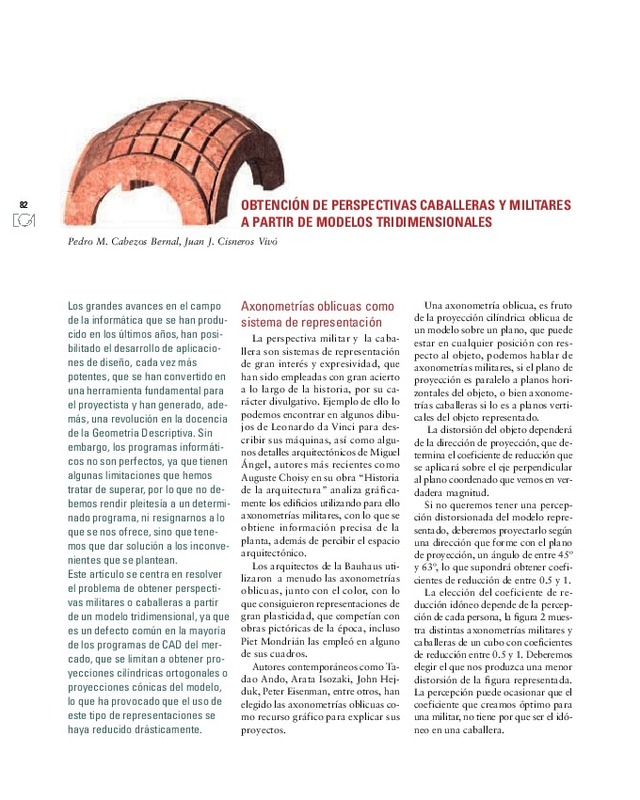JavaScript is disabled for your browser. Some features of this site may not work without it.
Buscar en RiuNet
Listar
Mi cuenta
Estadísticas
Ayuda RiuNet
Admin. UPV
OBTENCIÓN DE PERSPECTIVAS CABALLERAS Y MILITARES A PARTIR DE MODELOS TRIDIMENSIONALES
Mostrar el registro sencillo del ítem
Ficheros en el ítem
| dc.contributor.author | Cabezos Bernal, Pedro M.
|
es_ES |
| dc.contributor.author | Cisneros Vivó, Juan J.
|
es_ES |
| dc.date.accessioned | 2012-02-27T13:52:11Z | |
| dc.date.available | 2012-02-27T13:52:11Z | |
| dc.date.issued | 2010 | |
| dc.identifier.issn | 1133-6137 | |
| dc.identifier.uri | http://hdl.handle.net/10251/14816 | |
| dc.description.abstract | [EN] The great advances in the field of computers, have led the development of more powerful design applications, which have become an essential tool for the designer and have generated a revolution in descriptive geometry teaching. However, design software isn’t perfect, as it has some limitations that we try to overcome, so that, we shouldn’t comply with a particular application, or resign us to obtain only what it offers, so we have to find solutions to that limitations. This article focuses on solving the problem to obtain oblique perspectives from a three-dimensional model, because it’s a common lack in most CAD programs, since they only can obtain orthogonal projections and linear perspectives from the model. This inconvenient drives to the fact that employment of this type of representations it’s been drastically reduced. | es_ES |
| dc.description.abstract | [ES] Los grandes avances en el campo de la informática que se han producido en los últimos años, han posibilitado el desarrollo de aplicaciones de diseño, cada vez más potentes, que se han convertido en una herramienta fundamental para el proyectista y han generado, además, una revolución en la docencia de la Geometría Descriptiva. Sin embargo, los programas informáticos no son perfectos, ya que tienen algunas limitaciones que hemos tratar de superar, por lo que no debemos rendir pleitesía a un determinado programa, ni resignarnos a lo que se nos ofrece, sino que tenemos que dar solución a los inconvenientes que se plantean. Este artículo se centra en resolver el problema de obtener perspectivas militares o caballeras a partir de un modelo tridimensional, ya que es un defecto común en la mayoría de los programas de CAD del mercado, que se limitan a obtener proyecciones cilíndricas ortogonales o proyecciones cónicas del modelo, lo que ha provocado que el uso de este tipo de representaciones se haya reducido drásticamente. | |
| dc.language | Español | es_ES |
| dc.language | Inglés | |
| dc.publisher | Editorial Universitat Politècnica de València | es_ES |
| dc.relation.ispartof | EGA. Revista de Expresión Gráfica Arquitectónica | |
| dc.rights | Reserva de todos los derechos | es_ES |
| dc.title | OBTENCIÓN DE PERSPECTIVAS CABALLERAS Y MILITARES A PARTIR DE MODELOS TRIDIMENSIONALES | es_ES |
| dc.title.alternative | OBTAINING OBLIQUE PERSPECTIVES FROM THREE-DIMENSIONAL MODELS | |
| dc.type | Artículo | es_ES |
| dc.date.updated | 2012-02-20T10:49:00Z | |
| dc.identifier.doi | 10.4995/ega.2010.1014 | |
| dc.rights.accessRights | Abierto | es_ES |
| dc.description.bibliographicCitation | Cabezos Bernal, PM.; Cisneros Vivó, JJ. (2010). OBTENCIÓN DE PERSPECTIVAS CABALLERAS Y MILITARES A PARTIR DE MODELOS TRIDIMENSIONALES. EGA. Revista de Expresión Gráfica Arquitectónica. 15(16):82-87. https://doi.org/10.4995/ega.2010.1014 | es_ES |
| dc.description.accrualMethod | SWORD | es_ES |
| dc.relation.publisherversion | https://doi.org/10.4995/ega.2010.1014 | es_ES |
| dc.description.upvformatpinicio | 82 | |
| dc.description.upvformatpfin | 87 | |
| dc.description.volume | 15 | |
| dc.description.issue | 16 | |
| dc.identifier.eissn | 2254-6103 |








